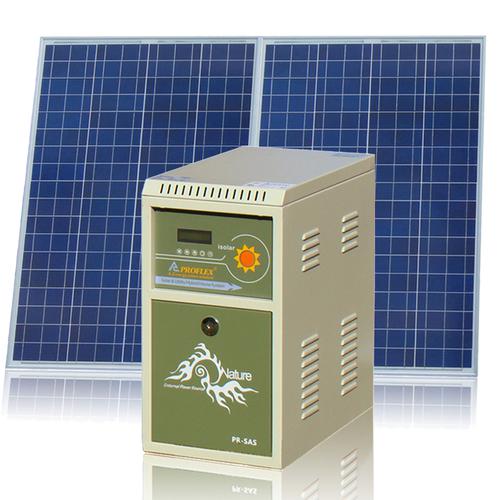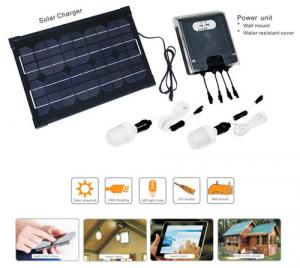Solar Energy Systems Brooklyn - Solar AC Power System with Maximum 150Wp 300W Output
- Loading Port:
- Tianjin
- Payment Terms:
- TT OR LC
- Min Order Qty:
- 10 set
- Supply Capability:
- 10000 set/month
OKorder Service Pledge
OKorder Financial Service
You Might Also Like
Specification
Daily use reference
TV 70W x 4 hours
Lighting 30W x 6 hours
Fan 50W x 6 hours
Laptop 60W x 2 hours
Total loading power: 210W
Total power consumption per day: 880Wh (0.88kWh/day)
AC solar power system consists of solar batteries, solar controller, battery, inverter components.
Used to solve rural or remote areas without electricity, such as highland, island, pastoral, villas, border posts and other military and civilian life electricity.
Model No. | PR-SAS300 |
Polycrystalline solar panel | 2pcs 75Wp parallel |
Max. solar panel charging voltage | 17.6V |
Max. solar panel charging current | 8.54A |
Inverter output | Pure sine wave 300W |
Inverter peak start | 900W (3s) |
Inverter output voltage/frequency | 220V/50Hz |
Inverter AC charger | 12V/10A |
Solar charge controller | 12V/15A |
Cabinet material | Steel box of zinc-plated and lacquer-coated |
Battery type | Deep cycle maintenance free |
Battery capacity | 1 x 12V 100Ah |
Operating temperature | -20oC-55oC |
Packing for solar panel | 0.06cbm/20kg |
Packing for integrated solar charge control inverter cabinet | 0.11cbm/15kg |
Packing for battery | 0.02cbm/31kg |
Whole system per set | 0.19cbm/66kg |
Optional monitoring software | CD-ROM for computer and SNMP card for internet |
FAQ
1. How do I decide which system is right for me ?
For protection from long outages, include a generator or solar panels in your Must solar system. Shorter outages can be handled by a battery-only system.
2. Where my system will be installed ?
Must solar systems are usually wall-mounted near a home's main electrical (circuit breaker) panel.
3. How do I install my system ?
A solar backup inverter is connected to a home electric system , we will supply detailed installation manual and videos for our customers .



- Q: How do solar energy systems impact energy storage technologies?
- Solar energy systems have a significant impact on energy storage technologies by creating a need for efficient and reliable storage solutions. As solar power generation is intermittent and dependent on weather conditions, energy storage technologies are crucial for storing excess energy produced during peak periods and releasing it during periods of low or no sunlight. This demand has driven advancements in energy storage, leading to the development of more efficient and cost-effective solutions like batteries and pumped hydro storage, ultimately enhancing the integration and reliability of solar energy systems.
- Q: Can solar panels be used to charge mobile devices?
- Yes, solar panels can be used to charge mobile devices.
- Q: Can a solar energy system be installed on a farm?
- Yes, a solar energy system can be installed on a farm. In fact, farms are great locations for solar installations due to their large open spaces and often abundant sunlight. Solar panels can be mounted on rooftops, barns, or even ground-mounted in fields, allowing farms to generate clean and renewable energy to power their operations. Additionally, solar energy systems can help farmers reduce their electricity bills, become more energy independent, and contribute to a sustainable and environmentally-friendly future.
- Q: What are the financial benefits of installing a solar energy system?
- Installing a solar energy system offers several financial benefits, including reduced electricity bills, potential income from excess energy generated, and long-term savings from avoiding rising energy costs. Additionally, solar energy systems often qualify for tax incentives and rebates, further enhancing the financial benefits.
- Q: Can solar energy systems be used for powering electric scooter charging stations?
- Solar energy systems have the capability to power electric scooter charging stations. The installation of solar panels on the rooftop or in an open area adjacent to the charging station enables the capture of sunlight, which is then converted into electricity. This eco-friendly and renewable energy source can be utilized to charge the scooters, consequently reducing dependence on grid electricity and decreasing carbon emissions. Moreover, by integrating energy storage solutions like batteries, excess energy generated during the day can be stored for use during periods of low sunlight or at night. This ensures an uninterrupted and dependable power supply for the charging stations. All in all, the utilization of solar energy systems for electric scooter charging stations presents a sustainable and environmentally conscious alternative.
- Q: Can solar energy systems be installed on recreational vehicles?
- Yes, solar energy systems can be installed on recreational vehicles. These systems are commonly used to power various appliances and devices in RVs, providing a sustainable and renewable source of energy while on the road.
- Q: What is the impact of hurricanes on solar panels?
- The impact of hurricanes on solar panels can be significant. Strong winds and flying debris during a hurricane can cause physical damage to the panels, leading to cracks, breakages, or even complete destruction. Additionally, heavy rain and flooding can damage the electrical components of the panels, reducing their efficiency or rendering them inoperable. Proper installation, maintenance, and storm preparation measures can help minimize the potential damage caused by hurricanes to solar panels.
- Q: Do solar energy systems require regular maintenance?
- Yes, solar energy systems do require regular maintenance.
- Q: Can solar energy systems be installed in urban areas with limited space?
- Yes, solar energy systems can be installed in urban areas with limited space. While it is true that urban areas often have limited rooftop space available for solar panel installation, there are several innovative solutions that can be implemented to overcome this challenge. One option is the installation of solar panels on vertical surfaces such as walls or facades of buildings. This approach maximizes the use of available space and does not require additional land. By utilizing vertical space, solar energy systems can still generate a significant amount of electricity even in densely populated urban areas. Another solution is the implementation of community solar projects. These projects involve the installation of solar panels in a centralized location within the urban area, such as a parking lot or a vacant lot. The electricity generated by these panels can then be shared among multiple buildings or households, allowing those with limited rooftop space to still benefit from solar energy. Furthermore, technological advancements have led to the development of more efficient and compact solar panels. These panels can generate the same amount of electricity as traditional panels with less surface area, making them more suitable for installation in limited urban spaces. In addition to these solutions, it is important to consider the potential for solar energy systems to be integrated into existing infrastructure. For example, solar panels can be installed on top of bus stops, streetlights, or even on the sides of bridges and highways. This allows for the utilization of spaces that would otherwise remain unused. Overall, while limited space may pose a challenge, there are various ways to install solar energy systems in urban areas. With innovative approaches and advancements in technology, solar power can be harnessed even in densely populated cities, contributing to a more sustainable and renewable energy future.
- Q: How much space do I need for a solar energy system?
- The space required for a solar energy system depends on various factors such as the size of the system, the efficiency of the solar panels, and the amount of energy you want to generate. Generally, for a residential system, you would need around 100-400 square feet of roof space per kilowatt of solar panels. However, it is recommended to consult with a solar energy professional who can assess your specific needs and determine the exact space requirements for your solar energy system.
Send your message to us
Solar Energy Systems Brooklyn - Solar AC Power System with Maximum 150Wp 300W Output
- Loading Port:
- Tianjin
- Payment Terms:
- TT OR LC
- Min Order Qty:
- 10 set
- Supply Capability:
- 10000 set/month
OKorder Service Pledge
OKorder Financial Service
Similar products
Hot products
Hot Searches
Related keywords
































